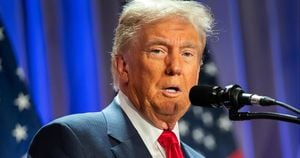Donald Trump’s promises of hefty tariffs on imports from Mexico, Canada, and China have stirred concern among economists, policymakers, and business leaders alike. The former president-elect recently pledged to apply tariffs of 25% on goods imported from Mexico and Canada and additional 10% on products from China. At the heart of Trump’s economic stance is his assertion aimed at curbing illegal immigration and the influx of fentanyl—a potent synthetic opioid—crossing the southern U.S. border.
Regardless of the intention behind these tariffs, the mere announcement has ignited discussions over potential economic fallout. While some see this as Trump’s attempt to leverage trade negotiations, others fear it may spark trade wars leading to increased prices on everyday goods for American consumers. Trump's tumultuous relationship with trade matters is nothing new; his previous term saw initiated tariffs on several imports, but the results were mixed. Many wonder: will this time be different?
President Joe Biden’s administration has reacted swiftly against Trump's tariff threats. During Thanksgiving, Biden suggested it would be unwise to implement such measures against U.S. allies. He underscored the importance of strong relationships with neighboring countries, stating, “The last thing we need to do is begin to screw up those relationships. I think we’ve got them in a good place.” He expressed hope for Trump's reconsideration, deeming the tariffs "counterproductive" for economic collaboration.
Both American and Canadian manufacturing sectors are prepared for the ripple effects of the proposed tariffs. Research shows nearly one-quarter of new vehicles sold within the U.S. originates from either Mexico or Canada, constituting significant components of the North American auto industry. For automakers already reeling from the inflation spurred by pandemic disruptions, the new tariffs could translate to increased production costs and higher prices for consumers. Reports indicate this could potentially raise vehicle prices by 10% at the dealership, which is particularly alarming for the auto industry, where manufacturers like Ford, General Motors, and Stellantis heavily depend on cross-border supply chains.
Meanwhile, agricultural sectors are also bracing for impact. Mexico constitutes the dominant supplier of fresh produce to U.S. grocery stores, providing 50% of the nation’s fruits and nuts. Tariffs on import goods like avocados and tomatoes would irrefutably drive up grocery prices, exacerbated by the existing inflation germinated during the COVID-19 pandemic. Industry experts predict American consumers will feel the bite at the checkout lines if the tariffs come to fruition. With food prices already on many people's minds—90% of voters report being concerned about rising grocery costs—further price inflation could weigh heavily on American households.
On the flip side, Trump justifies his tariff strategy by arguing it would pressure Mexico and Canada to tackle the issues of undocumented immigration and drug trafficking effectively. He stated emphatically, “We hereby demand they use this power, and until such time, they will pay a very big price!” Trump's previous administration primarily focused on these problems through stringent immigration policies, and he seems eager to instate similar tactics moving forward.
Experts remain divided on the efficacy of Trump's strategy. Some, like former White House adviser Steve Moore, argue the tariffs are merely bargaining chips intended to renegotiate trade agreements. He suggests it is “probably a bargaining tool,” reflecting Trump's unpredictable nature. Conversely, others warn of the potential for significant backlash if tensions escalate between the U.S. and its trade partners. Costly trade feuds could send shockwaves through the supply chain and lead to price escalations affecting not just luxury goods but everyday staples.
While Trump’s economic approach hasn't been without criticism, recent data reflects he is stepping back onto the national stage subsequent to what he describes as the restoration of America’s economy. At the time of writing, inflation rates have receded significantly (down to approximately 2.6%) from highs experienced earlier. Some economic analysts express optimism about Trump capitalizing on these trends to reinforce his political narrative.
Compounding the complexity of this situation are advances within the U.S. automotive industry. To mitigate potential losses, industry representatives are advocating for trade policies emphasizing collaboration over conflict. Nevertheless, automakers remain poised and prepared to tackle rising production costs if tariffs are enacted.
Interestingly, Trump's proposed tariffs are not limited to vehicles and agricultural products; electronics could also see surging prices. Major retailers such as Walmart and Best Buy anticipate raising prices across their electronic goods owing to tariffs on imports from China. Containing nearly 30% of all U.S. imports, consumer electronics like smartphones, video game consoles, and computers could become significantly costlier, directly affecting countless American households relying on these goods for daily activities.
Conclusion aside, it remains to be seen how Trump's pledges will materialize and what economic repercussions will follow suit. Discussions are underway, businesses are watching closely, and workers who depend on the health of the manufacturing and agricultural industries face uncertainty. The next chapters of U.S. economic policy could bear weighty reflections of Trump’s approach about trade and tariffs—how they will shape relationships with neighbors as well as the consumers they serve is still up for discussion.



